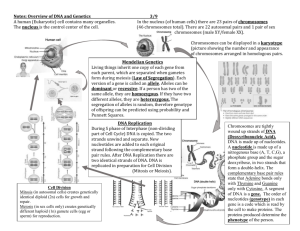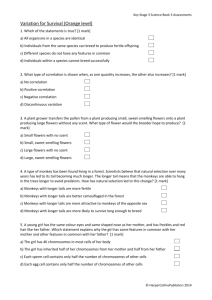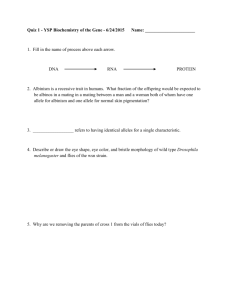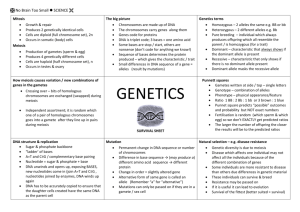UNIT 2 GENETICS TEST /77 Part A: Knowledge and Understanding
advertisement
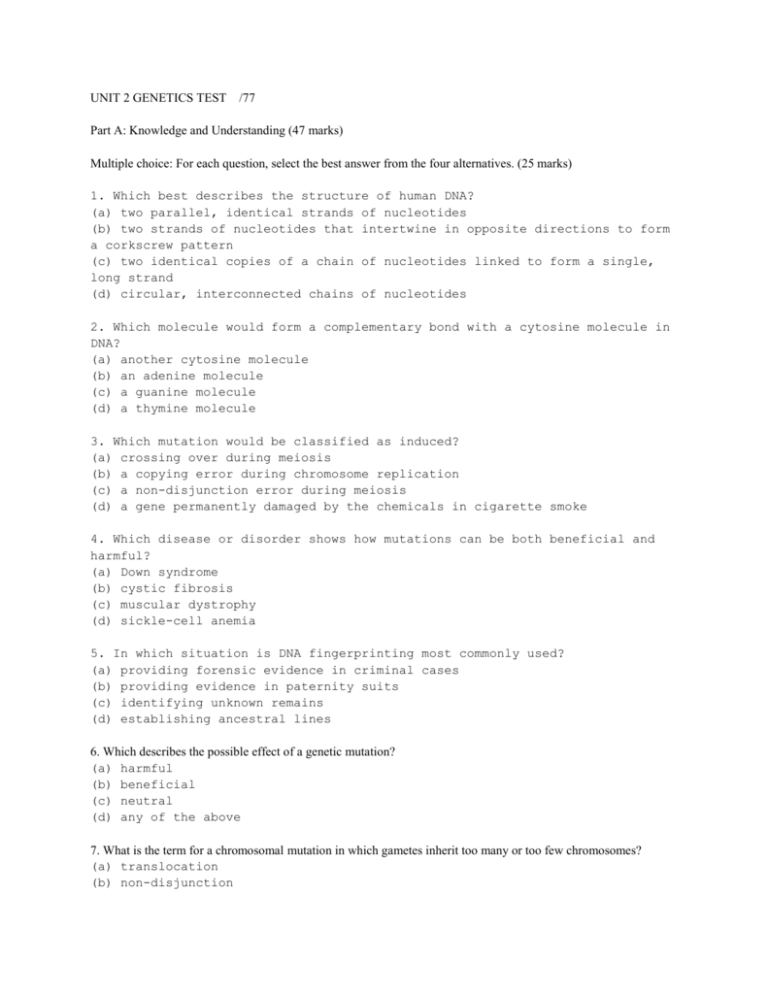
UNIT 2 GENETICS TEST /77 Part A: Knowledge and Understanding (47 marks) Multiple choice: For each question, select the best answer from the four alternatives. (25 marks) 1. Which best describes the structure of human DNA? (a) two parallel, identical strands of nucleotides (b) two strands of nucleotides that intertwine in opposite directions to form a corkscrew pattern (c) two identical copies of a chain of nucleotides linked to form a single, long strand (d) circular, interconnected chains of nucleotides 2. Which molecule would form a complementary bond with a cytosine molecule in DNA? (a) another cytosine molecule (b) an adenine molecule (c) a guanine molecule (d) a thymine molecule 3. Which mutation would be classified as induced? (a) crossing over during meiosis (b) a copying error during chromosome replication (c) a non-disjunction error during meiosis (d) a gene permanently damaged by the chemicals in cigarette smoke 4. Which disease or disorder shows how mutations can be both beneficial and harmful? (a) Down syndrome (b) cystic fibrosis (c) muscular dystrophy (d) sickle-cell anemia 5. In which situation is DNA fingerprinting most commonly used? (a) providing forensic evidence in criminal cases (b) providing evidence in paternity suits (c) identifying unknown remains (d) establishing ancestral lines 6. Which describes the possible effect of a genetic mutation? (a) harmful (b) beneficial (c) neutral (d) any of the above 7. What is the term for a chromosomal mutation in which gametes inherit too many or too few chromosomes? (a) translocation (b) non-disjunction (c) frameshift defect (d) autosomal error 8. Which of the following is another name for a transposon? (a) regulator gene (b) jumping gene (c) promoter gene (d) frameshift gene 9. About how many genes are there in the human genome? (a) 200 (b) 2000 (c) 20 000 (d) 200 000 10. Which of the following is the preferred term for "junk" DNA? (a) mutated DNA (b) transposed DNA (c) interpolated DNA (d) non-coding DNA 11. Which of the following physical traits represents a potential cost of sexual reproduction? (a) a striped coat that enables camouflage (b) great speed (c) brightly coloured feathers that could alert predators (d) acute night vision 12. How many chromosomes do normal human body cells contain? (a) 23 (b) 24 (c) 46 (d) 92 13. Asexual reproduction is rare among which of the following groups? (a) unicellular organisms (b) plants and fungi (c) invertebrates (d) vertebrates 14. Which of the following stages of mitosis is shown in Figure 1 (below)? (a) prophase (b) metaphase (c) anaphase (d) telophase Figure 1 Image: An illustration showing a stage of mitosis: chromosomes are pulled to the opposite ends of the cell. 15. Which of the following methods of reproduction results in offspring that are genetically different from a parent? (a) budding (b) fragmentation (c) sexual reproduction (d) all of the above 16. In humans, spermatogenesis begins with a somatic cell that has 46 chromosomes. When spermatogenesis is complete, how many sperm cells will be formed and how many chromosomes will each sperm cell contain? (a) 4 sperm cells each containing 23 chromosomes (b) 2 sperm cells each containing 46 chromosomes (c) 4 sperm cells each containing 46 chromosomes (d) 2 sperm cells each containing 23 chromosomes 17. During meiosis I, chromosomes exchange genetic information, a process known as (a) independent assortment (b) oogenesis (c) crossing over (d) interphase 18. Sex cells are called (a) autosomes (b) monosomes (c) trisomes (d) gametes 19. Chromosomes that are not sex chromosomes are called (a) autosomes (b) monosomes (c) trisomes (d) gametes 20. Down syndrome occurs because of (a) a meiosis error (b) non-disjunction (c) trisomy (d) all of the above 21. Mendel's pea plants were useful for his experiments because for many characteristics, such as seed shape, flower colour, and plant height, they exhibited complete dominance and had only two (a) chromosomes (b) alleles (c) genes (d) genotypes 22. Guanine, thymine, adenine, and cytosine are (a) phosphate groups (b) nitrogenous bases (c) sugars (d) none of the above 23. Approximately how many base pairs make up the human genome? (a) 300 (b) 3000 (c) 3 000 000 (d) 3 000 000 000 24. What pattern of dominance is shown in Figure 2 (below)? (a) complete dominance (b) incomplete dominance (c) codominance (d) none of the above Figure 2 Image: Illustration of a cube broken into four equal parts to show the dominance of a trait (coloring) between a white cow (HwHw) and a red bull (HrHr). They produce all roan calves (HrHw) – both colours are present 25. Which of the following options is a correct complementary base pair of DNA? (a) adenine and thymine (b) cytosine and thymine (c) guanine and adenine (d) guanine and thymine True/False: Indicate whether each statement is true or false. If you think the statement is false, rewrite it to make it true. (15 marks) 26. Barbara McClintock experimented with mutations in corn caused by ultraviolet radiation. 27. An infection that does not respond to antibiotics is likely caused by a resistant virus. 28. The nucleotide sequence ATCGGGTAT would be complementary to TAGCCCATA. 29. The human genome consists of about 3 million base pairs. 30. Mice are a good genetic model for humans. 31. Organisms that reproduce asexually inherit half their genetic information from one parent. 32. Mitotic cell division results in two daughter cells that are genetically identical to each other and to the parent cell. 33. Cloned populations are more susceptible to certain diseases because of their lack of genetic variability. 34. Gametogenesis produces sex cells with half the number of chromosomes as a body cell. 35. When homologous chromosomes fail to separate during meiosis, non-disjunction occurs. 36. Plants that, when self-pollinated, always produce offspring with the same trait are called hybrids. 37. An organism with two identical alleles for a trait is said to be homozygous for that trait. 38. A Punnett square is a chart that tracks the inheritance of a trait through a family. 39. An organism whose phenotype is a blend of different traits exhibits codominance. 40. Because of complementary base pairing, if you know the base sequence of one strand of DNA, you cannot predict the sequence of the other strand. Short Answer 41. In what molecules is genetic information stored? (Include both the full and abbreviated names.) (1 mark) 42. At which phase of meiosis does crossing over occur? (1 mark) 43. Why is Down syndrome also called trisomy 21? (1 mark) 44. What is the likely coat colour of a dog that has codominant black and white alleles for coat colour? (1 mark) 45. What is a dihybrid cross? (1 mark) 46. What are the three chemical components of a DNA nucleotide? Describe their arrangement within a doublestranded DNA molecule. (2 marks) Part B: Thinking and Inquiry (12 marks) 47. In each case, state what kind of mutation has occurred if the original base sequence was TATACGGTA. (3 marks) (a) TATCGGTA... (b) TATACGGATA... (c) TATATGGTA... 48. Consider inherited mutations such as sickle-cell anemia and lactose tolerance. How do they make a person better adapted to his or her environment in certain circumstances? How have these mutations persisted in the human population? (2 marks) 49. Describe and illustrate the process of transposition of a gene from one chromosome to another within a genome. What is a transposon? (2 marks) 50. In meiosis, a cell produces four haploid daughter cells that carry different combinations of genes. (2 marks) (a) What is the advantage to a species of producing four haploid daughter cells carrying different combinations of genes instead of two diploid daughter cells that are genetically identical? (b) What is the disadvantage? 51. What are 2 principal differences between mitosis and meiosis? (2 marks) 52. What is 1 difference between meiosis I and meiosis II? (1 mark) Part C: Application (9 marks) 53. In a certain variety of plant, there are two alleles for seed colour-green (G) and yellow (g). The green allele is completely dominant over the yellow allele. Suppose that some of the offspring (F1 generation) of a pair of greenseeded plants (P generation) have yellow seeds. (a) What must be the genotypes of the P generation? Are those plants homozygous or heterozygous for seed colour? (b) What are the genotype(s) of the F1 generation? What proportion of the plants in the F1 generation is homozygous for seed colour and what proportion is heterozygous for seed colour? (c) What are the phenotypes of the F1 generation? (d) Construct a Punnett square to show the genotypes of the offspring (F2 generation) of two of the yellow-seeded F1 generation. (e) What would the genotype(s) and phenotype(s) of the F2 generation in part (d) be? (f) Is this problem an example of a monohybrid cross or a dihybrid cross? Explain. (g) Could you have performed a test cross to answer the questions about the F1 generation? Explain. Part D: Communication (9 marks) 54. (a) How can there be only four different human blood types when there are six different human blood genotypes? Use examples to explain. (5 marks) (b) When donating and receiving blood, which blood types can safely accept which blood types? (4 marks)

